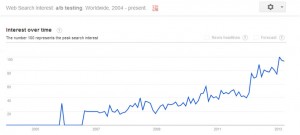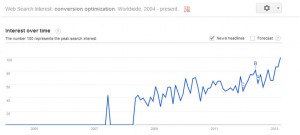When you look at some of the emerging topics in marketing – analytics, metrics, A/B testing, conversion optimization and the like – there seems to be a growing interest among marketers in what I like to call … evidence-based marketing.
Marketing, perhaps more than other business disciplines, has tended to rely on the “golden gut,” or a few high-performers. But, as the technology to measure and test marketing campaigns has become increasingly cheaper and more available, the ability to make marketing decisions based on real-world performance is a reality.
To help marketers become more evidenced-based, we’ve crafted the agenda for Optimization Summit 2013 in Boston around three key phases. No matter what phase you’re at, you can improve your ability in that phase, and try to move towards a more mature evidence-based marketing program. Here is a brief explanation of each phase, along with a sampling of resources to help you prepare for Optimization Summit 2013, or simply improve your own efforts.
Optimization is determining the value of the company, each product and each offer, and improving the communication of that value to the customer.
So, this includes landing page optimization and conversion rate optimization. But, it also includes messaging, copywriting, design and presentation.
It breaks down to two areas of collecting information – internally and externally. What have you learned from previous efforts to can improve your marketing campaigns? What have you learned from outside research, such as case studies, benchmark reports and networking with your peers?
Here are a few examples of resources to help you in the Optimization phase:
Converting PPC Traffic: How strategic keyword placement increased conversion by 144%
Email Optimization: A single word change results in a 90% lift in sign-ups
You’re in the Optimization phase when you’re making a concerted effort to improve your marketing campaigns based on what you have learned and think will work. However, this is only the beginning.
 Experimentation is testing to learn more about what values resonate, and what messaging and processes to secure transactions are most effective.
Experimentation is testing to learn more about what values resonate, and what messaging and processes to secure transactions are most effective.
It includes A/B split testing and understanding how to read your metrics and analytics to understand which treatment won.
But far beyond that, it also includes the ability to understand what makes a test valid or not, how to learn from your test results, and what to do with this information.
Here are a few examples of resources to help you in the Experimentation phase:
Online Marketing Tests: How could you be so sure?
MarketingExperiments methodology (learn from our methodology to help inform your own)
Optimization without Experimentation is just guesswork. Educated guesswork, perhaps, but it’s still guesswork.
While Optimization is certainly a crucial phase in evidence-based marketing, if you don’t pair Optimization with Experimentation, you aren’t truly making decisions based on what really works.
 Transformation focuses on not only applying what has been learned, but also helping your marketing team make a cultural shift within your organization.
Transformation focuses on not only applying what has been learned, but also helping your marketing team make a cultural shift within your organization.
Here are a few examples of resources to help you in the Transformation phase:
Creating a Culture of Testing: How to defeat the tyranny of best practices
Cost of Delay: How to win approval for your test and test schedule
Customer Theory: How we learned from a previous test to drive a 40% increase in CTR
In the Transformation phase, you have truly changed the way your organization makes decisions.
Marketing is built around a value proposition, discovered through Optimization and Experimentation. No longer are you relying on the marketer with the “golden gut,” you have a consistent, programmatic Experimentation program to help make decisions. Testing is not done in a vacuum, lessons from all Experimentation is used to build a Customer Theory.
It is certainly a difficult pinnacle to climb, but as Stephen Covey has said, “Begin with the end in mind.” I hope the focus on these three phases of evidence-based marketing can help you achieve your own marketing goals.
Related Resources:
Become a certified online testing professional with the MarketingExperiments Fundamentals of Online Testing Course
Online Testing: 6 test ideas to optimize the value of testimonials on your site
Test Interpretation: How over-measuring helped us discover a hidden 198% increase in leads







Great post! I especially like your redefinition of Marketing: “Marketing is built around a value proposition, discovered through Optimization and Experimentation”. This should be the correct marketers’ approach to analytics.